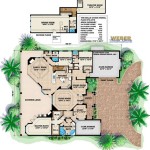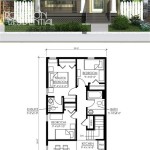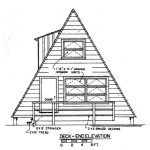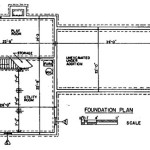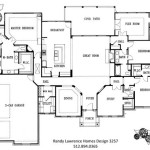Very Small House Plans, also known as micro-house plans or tiny house plans, are designs for homes under 500 square feet. These plans are becoming increasingly popular due to rising housing costs and the desire for more sustainable living. Tiny houses can be built from a variety of materials, including wood, metal, and even recycled materials.
One example of a very small house plan is the Tumbleweed Tiny House Company’s Cypress model. This house is 24 feet long and 8.5 feet wide, with a total of 208 square feet of living space. The house includes a kitchen, living room, bedroom, and bathroom. It is also equipped with solar panels and a composting toilet.
In the following sections, we will explore the different types of very small house plans available, the benefits of living in a tiny house, and how to choose the right plan for your needs.
When considering very small house plans, there are several important points to keep in mind:
- Size: Very small house plans are typically under 500 square feet.
- Layout: The layout of a tiny house must be carefully planned to maximize space.
- Materials: Tiny houses can be built from a variety of materials, including wood, metal, and recycled materials.
- Cost: Building a tiny house can be less expensive than building a traditional home.
- Sustainability: Tiny houses are more sustainable than traditional homes due to their reduced size and energy consumption.
- Maintenance: Tiny houses require less maintenance than traditional homes.
- Building codes: It is important to check with local building codes to ensure that your tiny house plan meets the requirements.
- Resale value: The resale value of tiny houses can be lower than that of traditional homes.
- Lifestyle: Living in a tiny house requires a minimalist lifestyle.
By understanding these points, you can make an informed decision about whether a very small house plan is right for you.
Size: Very small house plans are typically under 500 square feet.
The size of a very small house plan is one of the most important factors to consider. Tiny houses are typically under 500 square feet, and some are even smaller. This small size has several advantages:
- Affordability: Smaller homes are less expensive to build and maintain than larger homes.
- Sustainability: Smaller homes require less energy to heat and cool, and they produce less waste.
- Mobility: Smaller homes are easier to move than larger homes, which can be an important consideration for people who want to live a nomadic lifestyle.
However, it is important to note that living in a small space can also be challenging. It is important to carefully consider your needs and lifestyle before choosing a very small house plan. You should also make sure that you have a realistic understanding of the challenges of living in a small space.
Layout: The layout of a tiny house must be carefully planned to maximize space.
The layout of a tiny house is one of the most important factors to consider when designing your home. A well-planned layout can make a small space feel larger and more comfortable, while a poorly-planned layout can make even a large space feel cramped and cluttered.
There are several key considerations to keep in mind when planning the layout of your tiny house:
- Flow: The flow of your tiny house should be smooth and efficient. You should be able to move easily from one room to another without feeling cramped or obstructed.
- Multifunctionality: Every space in your tiny house should serve multiple functions. For example, your living room could also be your dining room and your bedroom could also be your office.
- Storage: Storage is essential in a tiny house. Make sure to include plenty of built-in storage, such as shelves, cabinets, and drawers.
- Natural light: Natural light can make a small space feel larger and more inviting. Include as many windows and skylights as possible in your design.
By carefully considering these factors, you can create a tiny house layout that is both functional and comfortable.
Materials: Tiny houses can be built from a variety of materials, including wood, metal, and recycled materials.
The materials you choose for your tiny house will have a significant impact on its cost, durability, and sustainability. Here are the most common materials used to build tiny houses:
- Wood: Wood is a popular choice for tiny houses because it is relatively inexpensive, easy to work with, and durable. However, wood is also susceptible to rot and insects, so it is important to properly seal and maintain your tiny house if you choose to build it with wood.
- Metal: Metal is another popular choice for tiny houses because it is durable, fire-resistant, and low-maintenance. However, metal can be more expensive than wood, and it can be more difficult to work with. Additionally, metal can be hot in the summer and cold in the winter, so it is important to insulate your tiny house properly if you choose to build it with metal.
- Recycled materials: Recycled materials can be a great way to save money and reduce your environmental impact when building a tiny house. However, it is important to carefully inspect recycled materials before using them to make sure that they are in good condition and free of contaminants.
Ultimately, the best material for your tiny house will depend on your individual needs and budget. However, by understanding the pros and cons of each material, you can make an informed decision about which material is right for you.
Cost: Building a tiny house can be less expensive than building a traditional home.
One of the biggest advantages of very small house plans is their affordability. Tiny houses are typically much less expensive to build than traditional homes, for several reasons:
- Materials: Tiny houses require less materials to build than traditional homes. This can save you a significant amount of money, especially if you choose to use recycled materials.
- Labor: Tiny houses can be built with less labor than traditional homes. This is because they are smaller and simpler to construct.
- Land: Tiny houses can be built on smaller lots than traditional homes. This can save you money on land costs, especially in expensive urban areas.
- Utilities: Tiny houses require less energy to heat and cool than traditional homes. This can save you money on your utility bills.
Overall, building a tiny house can be a great way to save money on your housing costs. However, it is important to keep in mind that there are also some additional costs associated with tiny houses, such as the cost of land and the cost of connecting to utilities. However, even with these additional costs, tiny houses are still typically much less expensive than traditional homes.
Sustainability: Tiny houses are more sustainable than traditional homes due to their reduced size and energy consumption.
Tiny houses are more sustainable than traditional homes for several reasons. First, their reduced size means that they require less materials to build. This can save a significant amount of energy and resources, especially if recycled materials are used.
Second, tiny houses are more energy-efficient than traditional homes. This is because they have a smaller surface area to heat and cool, and they are typically better insulated. As a result, tiny houses can use less energy to maintain a comfortable indoor temperature, which can save money on utility bills and reduce greenhouse gas emissions.
Third, tiny houses produce less waste than traditional homes. This is because they require less materials to build and maintain, and they generate less garbage. Additionally, tiny houses are often designed with sustainability in mind, and they may include features such as composting toilets and solar panels.
Overall, tiny houses are a more sustainable option than traditional homes. Their reduced size, energy efficiency, and waste reduction make them a great choice for people who want to live a more environmentally friendly lifestyle.
Maintenance: Tiny houses require less maintenance than traditional homes.
Tiny houses require less maintenance than traditional homes for several reasons. First, they are smaller, which means that there is less to maintain. Second, tiny houses are often built with durable materials that require less upkeep. Third, tiny houses are typically simpler in design, which means that there are fewer systems and appliances that can break down.
- Exterior maintenance: The exterior of a tiny house is typically easier to maintain than the exterior of a traditional home. This is because tiny houses have less surface area to paint or stain, and they often have simpler roofs. Additionally, tiny houses can be built with durable materials, such as metal or fiber cement siding, which require less maintenance than traditional materials, such as wood.
- Interior maintenance: The interior of a tiny house is also typically easier to maintain than the interior of a traditional home. This is because tiny houses have less square footage to clean and maintain. Additionally, tiny houses often have fewer rooms and less clutter, which makes it easier to keep them clean and organized.
- Systems and appliances: Tiny houses typically have fewer systems and appliances than traditional homes. This means that there are fewer things that can break down and require repair. Additionally, the systems and appliances in tiny houses are often smaller and simpler, which makes them easier to maintain and repair.
- Overall maintenance costs: Overall, the maintenance costs for a tiny house are typically lower than the maintenance costs for a traditional home. This is because tiny houses require less time, effort, and money to maintain.
If you are considering building or buying a tiny house, be sure to keep in mind the low maintenance costs. This is one of the many benefits of living in a tiny house.
Building codes: It is important to check with local building codes to ensure that your tiny house plan meets the requirements.
Building codes are regulations that govern the construction of buildings. These codes are in place to ensure that buildings are safe and habitable. Tiny houses are subject to the same building codes as traditional homes, so it is important to check with your local building department to make sure that your tiny house plan meets the requirements.
Building codes vary from place to place, so it is important to check with your local building department to find out the specific requirements for your area. However, there are some general requirements that are common to most building codes. These requirements typically include:
- Foundation: The foundation of your tiny house must be strong enough to support the weight of the house and its occupants. The foundation must also be able to withstand the local climate and soil conditions.
- Framing: The framing of your tiny house must be strong enough to support the weight of the house and its occupants. The framing must also be able to withstand the local climate and wind loads.
- Electrical: The electrical system in your tiny house must be installed in accordance with the National Electrical Code (NEC). The NEC is a set of regulations that govern the installation of electrical systems in buildings.
- Plumbing: The plumbing system in your tiny house must be installed in accordance with the International Plumbing Code (IPC). The IPC is a set of regulations that govern the installation of plumbing systems in buildings.
- Heating and cooling: The heating and cooling system in your tiny house must be installed in accordance with the International Mechanical Code (IMC). The IMC is a set of regulations that govern the installation of heating and cooling systems in buildings.
If your tiny house plan does not meet the local building codes, you will need to make changes to the plan before you can build your house. It is important to work with a qualified contractor to ensure that your tiny house is built to code.
Building codes are in place to protect the health and safety of the public. By following the building codes, you can ensure that your tiny house is safe and habitable.
Resale value: The resale value of tiny houses can be lower than that of traditional homes.
The resale value of a tiny house is typically lower than that of a traditional home. This is due to several factors, including:
- Size: Tiny houses are smaller than traditional homes, which can make them less desirable to some buyers.
- Lack of traditional amenities: Tiny houses often lack traditional amenities, such as multiple bedrooms, bathrooms, and garages. This can make them less appealing to buyers who are looking for a more traditional home.
- Zoning restrictions: Tiny houses may not be allowed in all zoning districts. This can make it difficult to find a buyer for your tiny house if you decide to sell it.
- Stigma: There is still some stigma associated with tiny houses. Some people view tiny houses as being too small, cramped, and uncomfortable. This stigma can make it difficult to sell a tiny house for a high price.
However, it is important to note that the resale value of tiny houses is increasing as more and more people become interested in this type of housing. Additionally, there are several things you can do to increase the resale value of your tiny house, such as:
- Build your tiny house on a permanent foundation. This will make your tiny house more appealing to buyers who are looking for a more traditional home.
- Add traditional amenities to your tiny house. This could include adding an extra bedroom, bathroom, or garage.
- Make sure your tiny house is built to code. This will show buyers that your tiny house is safe and well-built.
- Market your tiny house to the right buyers. This includes marketing your tiny house to people who are interested in sustainable living, downsizing, or living a minimalist lifestyle.
By following these tips, you can increase the resale value of your tiny house and make it more appealing to potential buyers.
Overall, the resale value of tiny houses is lower than that of traditional homes. However, there are several things you can do to increase the resale value of your tiny house. By following the tips above, you can make your tiny house more appealing to potential buyers and get a good price for your home when you decide to sell it.
Lifestyle: Living in a tiny house requires a minimalist lifestyle.
Living in a tiny house requires a minimalist lifestyle. This means that you need to be able to live with less stuff. You will need to be organized and efficient with your space. You will also need to be comfortable with living in a smaller space.
- Declutter: The first step to living in a tiny house is to declutter. This means getting rid of anything you don’t need or use. Be ruthless and only keep the things that are essential to your life.
- Organize: Once you have decluttered, you need to organize your belongings. This will help you to make the most of the space you have. Use shelves, drawers, and baskets to keep your things organized and out of the way.
- Be efficient: Living in a tiny house requires you to be efficient with your space. This means using every inch of space wisely. Consider using multi-purpose furniture and storage solutions.
- Be comfortable: Living in a smaller space can be a challenge. It is important to make sure that you are comfortable in your tiny house. This means choosing furniture that is comfortable and fits well in your space.
Living a minimalist lifestyle can be a challenge, but it is also very rewarding. By living with less, you can simplify your life and focus on the things that are truly important to you.










Related Posts

